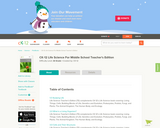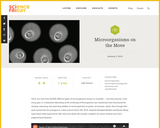
This parent guide supports parents in helping their child at home with the 7th grade Science content.
- Subject:
- Science
- Material Type:
- Reference Material
- Vocabulary
- Author:
- Kelly Rawlston
- Letoria Lewis
- Date Added:
- 10/11/2022

This parent guide supports parents in helping their child at home with the 7th grade Science content.

This resource accompanies our Rethink 7th Grade Science course. It includes ideas for use, ways to support exceptional children, ways to extend learning, digital resources and tools, tips for supporting English Language Learners and students with visual and hearing impairments. There are also ideas for offline learning.

In this lesson plan from the Utah Education Network, students will read a summarization of Van Leeuwenhoek's life and work and answer questions to check for understanding. The summarization and questions are included.

In this activity students make and use coverslip traps as a method to collect bacteria and microorganisms from marine and freshwater environments. Many organisms, including bacteria, ciliates and diatoms will colonize bare surfaces in an aqueous environment. By providing a substrate one can encourage the formation of these biofilms. Coverslips are a suitable substrate for colonization, and can easily be observed under the microscope.

In this activity, students make and use simple nets to collect plankton, organisms that spend all or some of their lives living at the water surface. Viruses, bacteria, protists, fungi, and animals ranging in size from nanometers to several centimeters can all be found in the plankton of fresh or marine waters.

In this activity students make and use styrofoam traps as a method to collect bacteria and microorganisms from marine and freshwater environments. The tiny spaces in foam peanuts and blocks of polyurethane foam can be colonized by microorganisms.

This is a supplemental resource to be used with the lesson "The Fabulous Life of Protists." In this lesson, students will utilize inquiry skills to observe and research various protists. This is the first of 4 student sheets in this activity.

This is a supplemental resource to be used with the lesson "The Fabulous Life of Protists." In this lesson, students will utilize inquiry skills to observe and research various protists. This is the second of 4 student sheets in this activity.

This is a supplemental resource to be used with the lesson "The Fabulous Life of Protists." In this lesson, students will utilize inquiry skills to observe and research various protists. This is the third of 4 student sheets in this activity.

This is a supplemental resource to be used with the lesson "The Fabulous Life of Protists." In this lesson, students will utilize inquiry skills to observe and research various protists. This is the fourth of 4 student sheets in this activity.

Students will utilize inquiry skills to observe and research various protists.

In this Nature Center activity, students will identify microbes found in a pond or creek. They will collect samples using a Petri dish.

Students will use the microscope for observing live specimens of paramecium, amoeba, Euglena, and Spirogyra to discover the differences between algae and protozoans. After documenting their observations in their science journals, they will use the computer to create a brochure or slideshow presentation that compares the characteristics of the three groups of protozoans. A rubric is provided for assessment of student work.

In this lesson, students compare and contrast how unicellular and multicellular organisms perform the life processes of nutrition, digestion, and circulation through an investigation of paramecium.

CK-12 Life Science Honors For Middle School covers seven units: Understanding Living Things; Cells: The Building Blocks of Life; Genetics and Evolution; Prokaryotes, Protists, Fungi, and Plants; The Animal Kingdom; The Human Body; and Ecology.

With this resource, students will sketch pictures of actual protists including, paramecium, euglena, amoeba and algae.

In this activity, students will research and report on a microorganism.

In this lesson, students learn about ciliates and flagellates and compare and contrast paramecium and Euglena specimens.

In this interactive learning object, students will work side-by-side with a virtual instructor to review the basics of microscopy and perform a guided practice experiment, practice using the microscope at their own pace, and complete an assignment from their virtual instructor successfully to receive a certificate.

To complete this worksheet, students visit a series of web sites where they explore the history of the microscope and identify objects viewed at different magnifications.